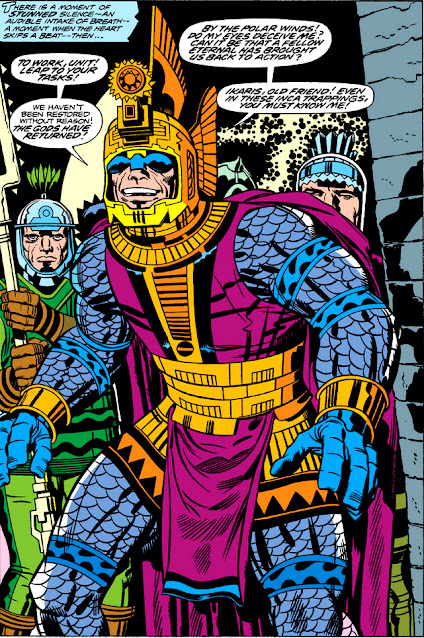When
Strange Tales ended its run in May of 1968, it served as a springboard which launched each of its two principal characters--Doctor Strange and Nick Fury--into their own titles the following month.
Doctor Strange would continue the former book's numbering and begin with issue #169--while the new
Nick Fury, Agent of S.H.I.E.L.D. book would start off with issue #1. Prior to then, Jim Steranko had shepherded the SHIELD segment of
Strange Tales successfully for fifteen issues, and it seemed that Marvel had
struck gold with Steranko and his interpretation of the man who had been
appointed as head of SHIELD. Who better, then, to spearhead Fury's new solo espionage series?
And yet the celebration of a new SHIELD series with Steranko at the helm was short-lived. As before, Steranko was working on a title being published monthly--but where Strange Tales offered a comfortable 11-12 pages for the writer/artist to produce, as he did for over a year, Steranko now found himself on the hook for twenty pages of story per month--inevitably running into deadline pressures as early as issue #4, when a story by Roy Thomas and artist Frank Springer was substituted and which retold Fury's installment as head of SHIELD and covered the events from Strange Tales #135 in more detail. Issue #5 subsequently turned out to be Steranko's final work on the series (though he would turn in cover art for issues 6-7), after which Springer would return as artist and several scripters would try their hand on the book.
But Steranko's early work for the series was nevertheless something to behold. It was here he would introduce the character of Scorpio, who would later turn up as a member of the Zodiac crime cartel but who flies solo in this series and whose true identity will elude Fury until Steranko's departure. Until then, Scorpio would relentlessly pursue bringing about the death of Fury--beginning with an elaborate scheme that would use the resources of SHIELD itself, a scheme that would backfire thanks to the tenacity of its intended victim.
The battle between the two see-saws back and forth--but just as Fury seems poised to learn Scorpio's identity, a twist to this tale reaches its climax that first allows the villain to escape, only to then bring about his apparent death.
Yet Scorpio returns in Steranko's final issue, as Fury pursues a lead from SHIELD's telepathic operatives and he's forced into evading a series of attacks launched by the key of the Zodiac, which ultimately hem in on him and culiminate in his capture.
Scorpio's scheme this time is to cast a mask that allows him to impersonate Fury within SHIELD, and then arrange for Fury himself to replace a Life Model Decoy unit scheduled to be tested in a deadly chamber of fatal traps--nor do Fury's fellow agents realize the LMD is their leader, given that the face is masked (then pull it back, Fury--even I knew that!) and they're aware that the unit was programmed with Fury's own reactions and reflexes. Clearly Scorpio has an axe to grind with Fury that involves stress and suffering rather than killing the man when he was unconscious and helpless.
Yet, again, Steranko provides twists to this story that involve more than Fury and Scorpio--and eventually, circumstances result in Fury's pursuit of his foe, the man's literal unmasking, and another apparent end to the villain.
Scorpio would resurface (heh, get it?) in Avengers #72, where Fury has faked his own death (thanks to an attack by Bullseye) in order to infiltrate Zodiac as (you guessed it) Scorpio. Once the dust settles on the defeated cartel, and the Avengers learn that Fury is alive, the mystery of Scorpio's identity is at last revealed by Thomas, as Fury recounts what he'd learned in that last chase in which he saw Scorpio alive.
In closing the circle, Thomas also pays a bit of homage to Steranko's dramatic splash pages from issues 1 and 5 of Nick Fury, Agent of Shield, though Thomas's effort is somewhat disappointing in that it boils down to a play on words which takes its material from the lead-in to a joke.
Gerry Conway would also contribute his two cents in a Defenders story where Scorpio is out to create his own members of Zodiac, but sticks to Steranko's general theme for the splash page's wording:
Before Steranko would bring Scorpio back for his curtain call, he would provide us with some unorthodox Fury stories which featured the return of Jimmy Woo in his first appearance as a SHIELD agent, followed by a 1930s scientist bent on wiping out mankind--as well as a mystery which plays off Sir Arthur Conan Doyle's "The Hound of the Baskervilles"* (with an evil Nazi plot twist):
*Which, granted, strays from the "Agent of SHIELD" espionage angle a reader might have been expecting from this title.
Once Steranko departs the series, he leaves behind two covers for the stories which follow--one of which won the 1968 Alley Award for Best Cover.
Nick Fury, Agent of SHIELD would last for 18 issues, the final six shifted to a bi-monthly schedule. Springer returned to the series for six issues post-Steranko, followed by an appearance by Barry Smith, with Herb Trimpe pencilling the next three. But the book effectively ceased publication with issue 15, at which time it began featuring only reprinted stories from Strange Tales Nick Fury segments until the plug was finally pulled. Oddly enough, even then Marvel was promoting the book with new cover art, recycling Strange Tales for all it was worth.
(To which Nick Fury might have replied, "Nuts!")
















































